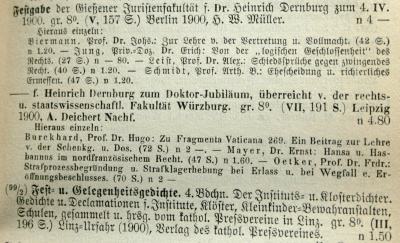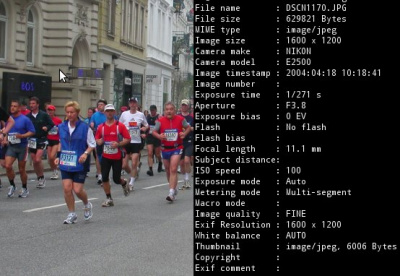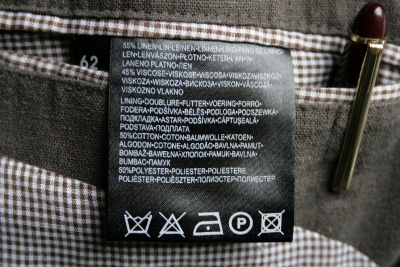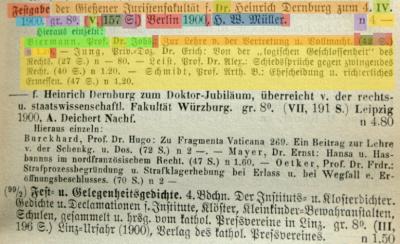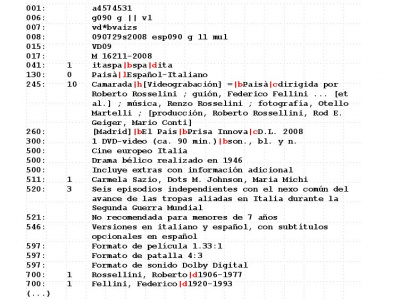Difference between revisions of "Metadata specifications in context"
From filmstandards.org
| Line 1: | Line 1: | ||
| − | ''From the TC 372 Workshop Compendium'' | + | ''From the [[TC 372 Workshop Compendium]]'' |
Metadata, as the name implies, is data about data. In current usage of the term, the meaning of data is not restricted to digitally encoded information, but can be almost anything. | Metadata, as the name implies, is data about data. In current usage of the term, the meaning of data is not restricted to digitally encoded information, but can be almost anything. | ||
| Line 73: | Line 73: | ||
|} | |} | ||
| + | {| style="float: right; border: 1px solid #BBB; margin: .46em 0 0 .2em;" | ||
| + | |- style="font-size: 86%;" | ||
| + | | valign="top" width="405px" |[[File:Hinrichs-markup.jpg|400px]]<br /> | ||
| + | <span class="imgcaption"> | ||
| + | From: Hinrichs' Halbjahreskatalog, 204. Fortsetzung, erstes Halbjahr 1900, Leipzig: Hinrichs, 1900. p.215. | ||
| + | </span> | ||
| + | | valign="top" width="405px" | | ||
| + | Defining metadata means defining structure. Basically, a metadata schema defines an artifical language, consisting of a vocabulary and a grammar. | ||
| + | |||
| + | Marking up the artificial grammar elements in the example on the left will easily exhaust your stock of felt-tip pens. | ||
| + | |} | ||
| + | |||
| + | {| style="float: right; border: 1px solid #BBB; margin: .46em 0 0 .2em;" | ||
| + | |- style="font-size: 86%;" | ||
| + | | valign="top" width="405px" |[[File:Bne-marc-record.jpg|400px]]<br /> | ||
| + | <span class="imgcaption"> | ||
| + | Catalogue Record from Biblioteca Nacional de España | ||
| + | </span> | ||
| + | | valign="top" width="405px" | | ||
| + | Librarians have devised a metadata standard in which elements are identified through a numbering scheme. Known as MARC (or variants thereof), this scheme | ||
| + | has developed from modest beginnings in the 1960s into a family of complex specifications. Variants of MARC have been adopted by the majority of libraries worldwide. | ||
| + | |||
| + | In recent years, MARC has increasingly been criticised for its inconsistent syntax and semantics. | ||
| + | |} | ||
| + | |||
| + | |||
| + | {| style="float: right; border: 1px solid #BBB; margin: .46em 0 0 .2em;" | ||
| + | |- style="font-size: 86%;" | ||
| + | | valign="top" width="405px" |[[File:Mic-xml-record.jpg|400px]]<br /> | ||
| + | <span class="imgcaption"> | ||
| + | Part of a catalogue record from the Moving Image Collections portal, http://mic.imtc.gatech.edu/. Retrieved Oct, 2010 | ||
| + | </span> | ||
| + | | valign="top" width="405px" | | ||
| + | The image on the left shows metadata encoded in XML. This encoding uses human-readable names for its elements, and nesting (i.e. elements enclosed by elements) as a way of expressing structure. | ||
| + | XML has become the most widely used encoding for data and metadata exchange. | ||
| + | It is largely neutral with respect to the semantics of data elements. Therefore, it can be used as an encoding for arbitrary data structures. | ||
| + | |} | ||
[[Category:TC 372 Compendium]] | [[Category:TC 372 Compendium]] | ||
Revision as of 19:33, 21 March 2011
From the TC 372 Workshop Compendium
Metadata, as the name implies, is data about data. In current usage of the term, the meaning of data is not restricted to digitally encoded information, but can be almost anything.
 Part of a catalogue record from the Moving Image Collections portal, http://mic.imtc.gatech.edu/. Retrieved Oct, 2010 |
The image on the left shows metadata encoded in XML. This encoding uses human-readable names for its elements, and nesting (i.e. elements enclosed by elements) as a way of expressing structure. XML has become the most widely used encoding for data and metadata exchange. It is largely neutral with respect to the semantics of data elements. Therefore, it can be used as an encoding for arbitrary data structures. |

